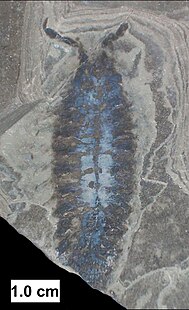| Waukesha Biota | |
|---|---|
| Stratigraphic range: Telychian-Sheinwoodian ~ | |
 Parioscorpio venator, an enigmatic arthropod from the Waukesha biota. | |
| Type | Konservat-Lagerstätte |
| Unit of | Brandon Bridge Formation |
| Area | Two quarries 32 km (20 mi) apart |
| Thickness | 12 cm (4.7 in) |
| Lithology | |
| Primary | Finely laminated interbedded mudstone |
| Other | Dolomite |
| Location | |
| Coordinates | 43°00′42″N 88°13′54″W / 43.01167°N 88.23167°W |
| Region | Waukesha County and Franklin, Milwaukee County, Wisconsin |
| Country | United States |
| Extent | Very localized |
| Type section | |
| Named for | Waukesha County, Wisconsin; not to be confused with the Waukesha Formation, which overlies the Brandon Bridge Formation |
The Waukesha Biota (also known as Waukesha Lagerstätte, Brandon Bridge Lagerstätte, or Brandon Bridge fauna) is an important fossil site located in Waukesha County and Franklin, Milwaukee County within the state of Wisconsin. This biota is preserved in certain strata within the Brandon Bridge Formation, which dates to the early Silurian period.[1] It is known for the exceptional preservation of soft-bodied organisms, including many species found nowhere else in rocks of similar age.[2] The site's discovery was announced in 1985, leading to a plethora of discoveries.[1][2][3] This biota is one of the few well studied Lagerstätten (exceptional fossil sites) from the Silurian, making it important in our understanding of the period's biodiversity.[1][2] Some of the species are not easily classified into known animal groups, showing that much research remains to be done on this site.[1][3] Other taxa that are normally common in Silurian deposits are rare here, but trilobites are quite common.[3]
- ^ a b c d Mikulic, Donald G.; Briggs, D.E.G.; Kluessendorf, Joanne (1985). "A new exceptionally preserved biota from the Lower Silurian of Wisconsin, U.S.A." Philosophical Transactions of the Royal Society of London B. 311 (1148): 75–85. Bibcode:1985RSPTB.311...75M. doi:10.1098/rstb.1985.0140. JSTOR 2396972.
- ^ a b c Jones, Wade T.; Feldman, Rodney M.; Schweitzer, Carrie E. (2015). "Ceratiocaris from the Silurian Waukesha Biota, Wisconsin". Journal of Paleontology. 89 (6): 1007–1021. doi:10.1017/jpa.2016.22. S2CID 131127241.
- ^ a b c Cite error: The named reference
WendruffBK&M2020was invoked but never defined (see the help page).
